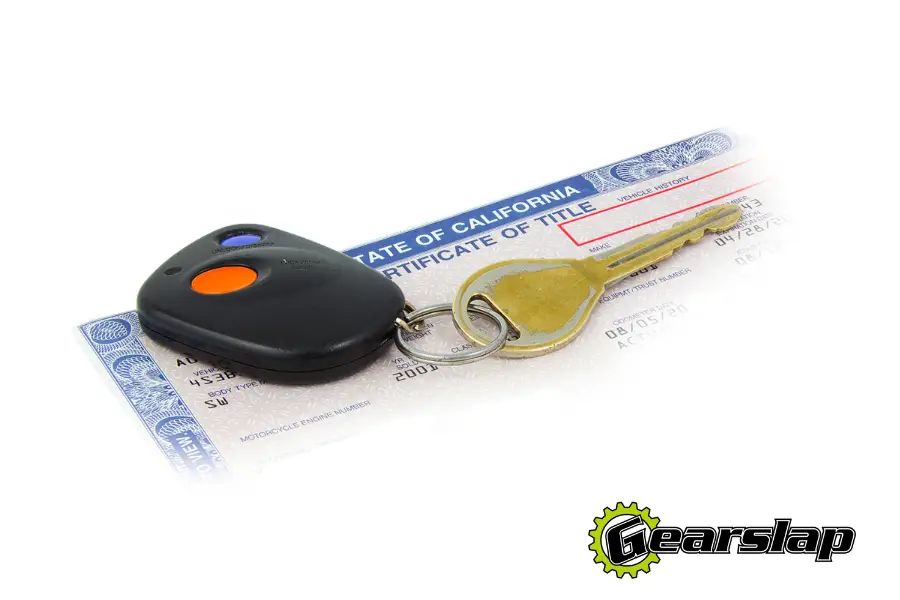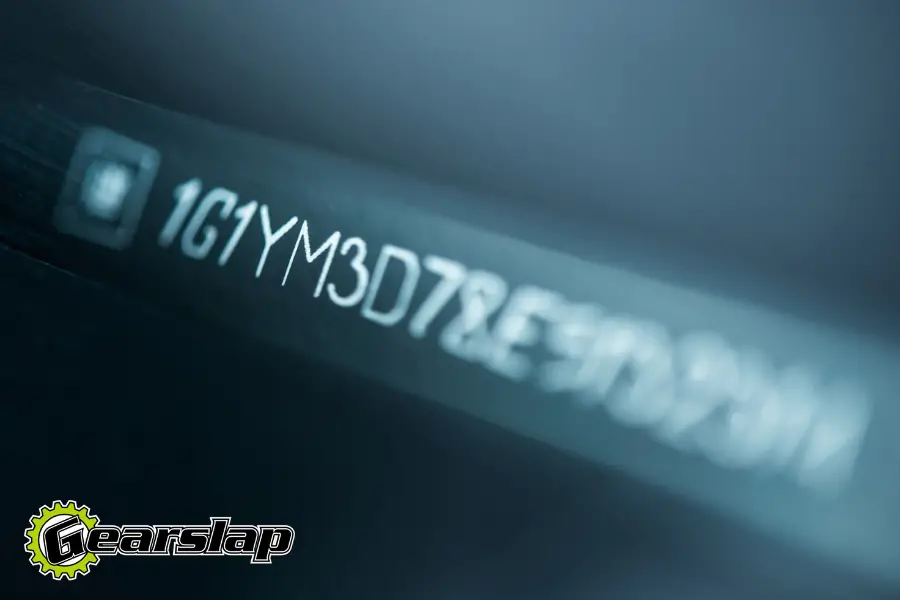Finding critical information on your California title can be challenging. Government title documents are littered with confusing numbers and letters. To make things easier, we offer guidance so you can easily locate the most important information, like the title number and VIN.
In particular, California seems to want to make everything more difficult than it needs to be when registering your car. It’s like they’re actively discouraging people from registering their cars – or buying one in the first place.
That’s part of the reason why I’d never live in California. If I had a job that told me I had to move there… I’d find another job!
I digress.
What Is a California Title?
A California title is legal documentation concerning a vehicle and ownership. This official document details the vehicle’s legal owner and other important vehicle information needed for identification purposes.
You need your title documents when registering the vehicle, and it contains many important details concerning your vehicle.

What Does a California Title Look Like?
Titles may not always look the same, especially if tied to an older car. But in general, California title documents are a soft shade of pink with a bright blue border about half an inch thick around the entire document.
At the top of the blue border, it will say “State of California,” and just below it, in the pink area, it will say “Certificate of Title.” Important vehicle identification information is in the top half of the paper.
The bottom half should contain the buyer and seller signatures, plus the odometer reading at the time of sale. California title documents are only one page, not multiple pages.
If the car seller attempts to give you a California title that looks different, like a black and white document, this is likely not a valid California vehicle title.
The California Title Number can be found in the upper right-hand corner of the title document. The words “Vehicle History” are usually just above the CA Title Number. In the image above, the number would be in the red box.
How To Get a Title
Obtaining a vehicle title should occur when you purchase the car, whether from a private seller, dealership, or another avenue. If you do not receive a vehicle title when you complete the purchase, you do not legally own the car and may have been a victim of scams.
The title should always be given at the time of purchase and should always remain with the current vehicle owner. You only have a car and won’t receive the title when financing a vehicle. The lien holder keeps the title until you pay the car off, and then they will send it to the new owner.
Finding Information on Your Title
We’ll walk you through how to read your California vehicle title and find the title number, along with other crucial information. A word of advice: photograph your vehicle title, in case you lose it, as you often need information on the title to acquire a replacement title. The most essential information to locate on your Title include:
- The title number
- The VIN (Vehicle Identification Number)
- The Letter ID
Let’s take a look at why each number is significant.
Title Number
Can’t find your title number? Don’t worry; the number is easy to find, and we’re here to help!
The title number is in the top left corner of the document. The title number is eight numbers long, listed above the VIN. It can be difficult to locate the title number because there is no title number label or heading.
When reading the legal document left to right, it’s the first numerical information, so it shouldn’t be hard to find once you know where to look.
What Is the Title Number?
Now let’s look at the title number’s meaning and why you might need it.
The title number is simply the identification of the title itself. The title number does not correspond with the vehicle’s specific identification number.
Instead, it identifies the title in the DMV’s database. So if you need to replace your title or perform a vehicle title search, the DMV does this using the title number. A vehicle title search is difficult without the title number.
The title number is not a fixed number. If you acquire new title documents for the vehicle via a replacement application, this new title will have a new title number.
Why You Might Need the Title Number:
- Title transfer
- Title replacement

VIN
If you need to find your VIN on your title, this is even easier than finding the title number!
You can find the VIN directly below the title number, except this sequence is labeled, making it easier to find.
Beneath the title number will say what the vehicle is, whether a passenger automobile, boat, or commercial vehicle. Directly below the type of vehicle, there will be a long sequence of characters labeled “vehicle ID number,” which is the VIN!
Despite the name, the VIN includes numbers and letters, so it’s technically a sequence, not a number. But it will be seventeen characters, but older cars may have shorter VINs. (we recently talked about my pet peeve when people call it a VIN number… number is part of the acronym!
Any automobile manufactured after 1982 will have seventeen characters. Cars made before 1981 can have a VIN between eleven and seventeen characters.
What Is the VIN?
VIN stands for vehicle identification number. Once again, despite the name, it’s technically a sequence of characters, not a number.
The VIN identifies the specific vehicle, so every vehicle has a unique VIN. The VIN may seem random, but it’s determined using distinct characteristics, including features, specifications, and the manufacturer.
The VIN is important because it identifies your car, and you need to provide it in certain scenarios. Even if a vehicle is the same make and model, the VIN differentiates the cars easily.
Unlike the title number, the VIN is the same forever, from the moment it’s manufactured to the day the car is junk.
Why You Might Need Your VIN:
- Identifying a stolen car
- Ordering replacement car parts
- Registering your vehicle
- Acquiring or renewing insurance
Letter ID
Unfortunately, the letter ID is more elusive than the VIN or title number. The letter ID is not on the title, which many people find frustrating and confusing. We know this can get complex, but we’ll try to make it as simple as possible.
The letter ID is not on your title, as it is on a literal letter from the DMV. When you first purchase or try to register a vehicle, you will receive a letter in the mail from the DMV. The letter ID will start with the letter “L”, followed by nine numbers (L123456789).
The ID is typically in italics in the upper right-hand corner of the DMV correspondence. If you never received this letter or think you threw it away, you can request another letter from the DMV, which can take up to a few weeks to reach you.
What Is the Letter ID?
The letter ID identifies you as the person who received the letter. The California DMV and registry services in other states use this to confirm people’s addresses and personal information concerning their vehicles. The IRS also uses similar letter IDs on mail for verification purposes.
Luckily, you typically only need a letter ID when you move, allowing the government agency to identify you in this new state. But the fleeting necessity of this ID makes it difficult to identify.
Why You Might Need the Letter ID:
- First-time vehicle registration in a state
- registration renewal in new state

Titles Vs. Registrations
Vehicle titles and registrations are official documents related to a vehicle, but there are a few differences. A title proves that you own the car, while a registration proves the car is safe to drive on the road.
You need to show your vehicle title when you want your car registered. And when law enforcement pulls you over, they typically ask for your license and registration, not your license and title.
However, if the car’s ownership is questioned, they may also ask to see the title to verify ownership.
You must transfer the title to the new owner when you sell or donate a car. However, they will have to have the car re-registered under their name. While titles and registrations are legally different documents, they contain much of the same helpful information you may be looking for.
FAQs
Vehicle titles, registrations, and transfers can be confusing and daunting. If you have more questions about California vehicle titles, check out the commonly asked questions answered below.
Are California titles for motorcycles different?
No, they are the same! If you are buying, selling, or registering a motorcycle in California, you need a vehicle title that looks like an automobile title.
How do I transfer a car title to someone else?
To transfer a title, you need to acquire all the necessary documentation related to the car. You can go to the DMV or local title office with the signed title and complete the transfer. You need to pay some transfer fees and taxes, and then vehicle ownership will successfully transfer to you!
What if I lost my California title?
If you lost or ruined your California title, you must submit an Application for Replacement or Transfer of Title (REG 227). This application must have the buyer and seller’s signature, along with other vehicle and title documents. But it is possible to receive a new title if you lost yours or if it’s mutilated or illegible.






